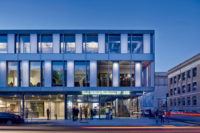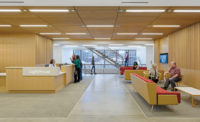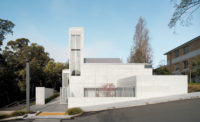Jump to credits & specifications
The San Francisco Opera has been entrenched at the War Memorial Opera House since it opened in 1932. One of a pair of Beaux-Arts structures owned by the city and located across the street from City Hall, the cultural landmark has a stately 3,146-seat auditorium that is ideal for grand opera but lacks the intimacy and scale for more modest performances. Looking toward the future, the 94-year-old company wanted a secondary venue in which it could mount smaller chamber and avant-garde works to attract the next generation of operagoers. Consolidating its back-of-house operations and administrative offices, scattered in various commercial buildings nearby, was also on its wish list. So the opera company hired Mark Cavagnero Associates to design an addition to the Beaux-Arts twin of the opera house in the War Memorial complex, the neighboring Veterans Building. It asked the firm, as a potential alternate strategy, to analyze that four-story structure’s uppermost level for a potential renovation. When the architects found that the latter strategy could be achieved at half the cost of an addition, SF Opera leased the fourth floor, and its rehabilitation proceeded accordingly.
The new Diane B. Wilsey Center for Opera is located directly above a popular 900-seat music and performing-arts venue. Once home of the San Francisco Museum of Art (now SFMOMA), the existing space consisted of gracious, skylit galleries and a central 4,600-square-foot sculpture court. After SFMOMA moved out in 1995, it was used as a law library, but then fell into disuse. Following historic-preservation guidelines, the design team’s intervention highlights the original interior and also adds the necessary functionality.
Improving the acoustics of the echoing galleries and isolating the music halls from the theater below was a significant challenge. The design team added 6 inches of concrete and a layer of acoustic insulation to the floor of the sculpture court (already fortified to hold heavy works of art), transforming it into a flexible 299-seat performance space, the Taube Atrium Theater. Maintaining an impressive pair of scagliola columns at the entrance to the theater lobby, the architects installed acoustic paneling around the room, retaining its ornate crown moldings and enhancing the chamfered corners of the ceiling with concealed uplights. The panels are light gray to set them apart from the white walls, and there’s a slight gap between the raised floors and original walls and columns. The small auditorium’s floor is made of end-grain Douglas fir, selected for its acoustic properties and minimally finished with oil to curtail its reflectivity.
Fulfilling the remainder of SF Opera’s brief, the architects created an orchestra-rehearsal hall in one of the long galleries, giving the floor a similar treatment to the Atrium Theater’s (minus the added concrete), inserting sound-insulating glass at the openings, and replacing a skylit laylight with a light-diffusive fabric that mimics the form and effect of the original glazing. This taut surface lets daylight into the room and transmits sound to an attic where it is received by discreet acoustic absorbers and reflectors. Two similar galleries house a dedicated costume studio and staff offices.
The Diane B. Wilsey Center for Opera is generating up to $20,000 per performance, and the company estimates that the consolidation of its operations is saving approximately $180,000 a year on rent alone. During its debut 2016 season, the new venue drew nearly 4,400 attendees, half of whom were new to SF Opera. “We were thrilled with that result,” says Jennifer Lynch, SF Opera’s managing director of philanthropy and audiences, adding that the first production of 2017 is sold out for its entire run.
Back to Good Design Is Good Business 2017
CreditsArchitect: Mark Cavagnero Associates — Mark Cavagnero, principal; Kang Kiang, principal in charge
Engineers: Tipping (structural); Airco Mechanical (mechanical); Decker Electric (electrical)
Consultants ARUP (theater/lighting/acoustics); Thornton Tomasetti (green building)
General contractor: Webcor
Client: San Francisco Opera
Size: 40,000 square feet
Cost: $18.8 million
Completion date: February 2016
|
SpecificationsFire-Rated Glass TGP Doors IAC Acoustics Theater Seats Segis Wood Flooring Kaswell |















Post a comment to this article
Report Abusive Comment